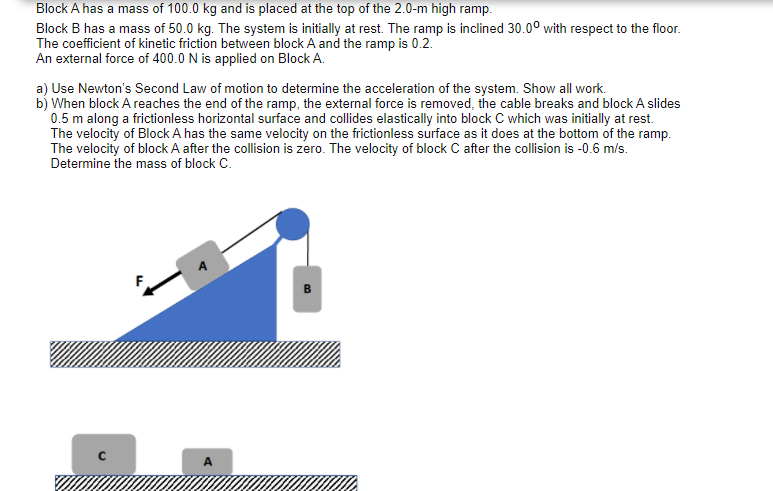Principles of Physics: A Calculus-Based Text
5th Edition
ISBN:9781133104261
Author:Raymond A. Serway, John W. Jewett
Publisher:Raymond A. Serway, John W. Jewett
Chapter5: More Applications Of Newton’s Laws
Section: Chapter Questions
Problem 12P: A block of mass 3.00 kg is pushed up against a wall by a force P that makes an angle of = 50.0 with...
Related questions
Question
show work

Transcribed Image Text:Block A has a mass of 100.0 kg and is placed at the top of the 2.0-m high ramp.
Block B has a mass of 50.0 kg. The system is initially at rest. The ramp is inclined 30.00 with respect to the floor.
The coefficient of kinetic friction between block A and the ramp is 0.2.
An external force of 400.0 N is applied on Block A.
a) Use Newton's Second Law of motion to determine the acceleration of the system. Show all work.
b) When block A reaches the end of the ramp, the external force is removed, the cable breaks and block A slides
0.5 m along a frictionless horizontal surface and collides elastically into block C which was initially at rest.
The velocity of Block A has the same velocity on the frictionless surface as it does at the bottom of the ramp.
The velocity of block A after the collision is zero. The velocity of block C after the collision is -0.6 m/s.
Determine the mass of block C.
в
Expert Solution
This question has been solved!
Explore an expertly crafted, step-by-step solution for a thorough understanding of key concepts.
Step by step
Solved in 2 steps with 2 images

Knowledge Booster
Learn more about
Need a deep-dive on the concept behind this application? Look no further. Learn more about this topic, physics and related others by exploring similar questions and additional content below.Recommended textbooks for you

Principles of Physics: A Calculus-Based Text
Physics
ISBN:
9781133104261
Author:
Raymond A. Serway, John W. Jewett
Publisher:
Cengage Learning

Physics for Scientists and Engineers, Technology …
Physics
ISBN:
9781305116399
Author:
Raymond A. Serway, John W. Jewett
Publisher:
Cengage Learning

College Physics
Physics
ISBN:
9781285737027
Author:
Raymond A. Serway, Chris Vuille
Publisher:
Cengage Learning

Principles of Physics: A Calculus-Based Text
Physics
ISBN:
9781133104261
Author:
Raymond A. Serway, John W. Jewett
Publisher:
Cengage Learning

Physics for Scientists and Engineers, Technology …
Physics
ISBN:
9781305116399
Author:
Raymond A. Serway, John W. Jewett
Publisher:
Cengage Learning

College Physics
Physics
ISBN:
9781285737027
Author:
Raymond A. Serway, Chris Vuille
Publisher:
Cengage Learning

College Physics
Physics
ISBN:
9781305952300
Author:
Raymond A. Serway, Chris Vuille
Publisher:
Cengage Learning

Physics for Scientists and Engineers: Foundations…
Physics
ISBN:
9781133939146
Author:
Katz, Debora M.
Publisher:
Cengage Learning

University Physics Volume 1
Physics
ISBN:
9781938168277
Author:
William Moebs, Samuel J. Ling, Jeff Sanny
Publisher:
OpenStax - Rice University